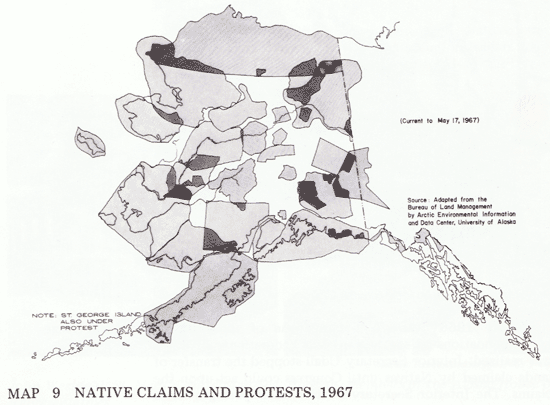
|
Alaska
Native Land Claims
|
|
|
Unit
4 - The
Land Claims Struggle
|
|
|
Chapter
17 - Proposed Legislation
|
|
Chapter 17
Proposed Legislation
Before 1966 drew to a close, one of the principal recommendations of the new Alaska Federation of Natives was realized: Interior Secretary Udall stopped the transfer of lands claimed by Natives until Congress could act upon the claims. The Interior Secretary's action of imposing a "land freeze" brought an immediate and angry response from State officials. Governor Walter Hickel, who had won the governorship in the 1966 election, complained in a letter to Udall that the land freeze denied the State its right to select its land entitlement under the provisions of the Statehood Act. Udall replied that both the Statehood Act and the Organic Act of 1884 recognized the existence of Native land rights, and that he could not give the state any lands claimed by Natives until the Congress enacted a settlement. He explained:
In the face of Federal guarantee that the Alaska Natives shall not be disturbed in the use and occupation of lands, I could not in good conscience allow title to pass into others' hands . . . Moreover, to permit others to acquire title to the lands the Natives are using and occupying would create an adversary against whom the Natives would not have the means of protecting themselves . . .
Arguing that Udall's action was illegal, the State of Alaska filed a lawsuit to require him to transfer lands to the State. Since the basis of the State's action was land it wanted near Nenana, the Nenana Native council joined in the lawsuit as an interested third party. More than two years would pass before a court ruling was given.
 |
Meanwhile, the extent of land affected by Udall's freeze was rapidly growing as additional claims or protests were filed by Native villages or organizations. By May of 1967, thirty-nine protests had been filed. They ranged in size from a 640-acre claim by the village of Chilkoot to the 58 million-acre claim of the Arctic Slope Native Association. Because many claims were overlapping, the total acreage under protest — about 380 million acres — was greater than the land area of the state.
First bills. The first two bills to resolve the claims were introduced in the Congress in the summer of 1967, one sponsored by the Department of the Interior, the other by the Alaska Federation of Natives (AFN). Both bills authorized a court to determine how much money should be paid to Natives for lands they had lost. The AFN bill would also have the court award title to lands with no maximum acreage specified. The Interior bill, on the other hand, would authorize a maximum of 50,000 acres per village in trust.
The Interior bill was criticized by Native spokesmen because the eight-to-ten million acres that would be granted was insufficient for traditional uses and because the land was to be in trust status.
AFN importance. In October of 1967 the one-year-old AFN met, resolved differences among members, and adopted a constitution. Among other things, the constitution tried to provide for a financial base for Federation operations: associations and villages were to provide funds to it according to their ability to pay.
The Federation had become the voice of Alaska's Natives in 1966. With the decisions made at its second meeting, it had become an even stronger voice.
The importance of the Federation was emphasized at the same meeting when Hickel's attorney general, Edgar Paul Boyko, proposed that the Federation and the State work together to develop a new proposal for settlement of the claims: Boyko agreed to a large land settlement, including the minerals beneath the surface. He said:
. . . we would like to provide subsurface rights, even to large grants of land . . . The State needs land — the Natives need lands. The State and the Natives should go into partnership.
 |
| Alice Brown, Kenaitze, the only woman on the State of Alaska's Land Claims Task Force |
Land Claims Task Force. Following the suggestion, a Land Claims Task Force was established under State sponsorship. Its chairman was State Representative Willie Hensley; members of its legislative drafting committee were leaders of Native organizations: Emil Notti, president of the Federation; John Borbridge, Jr., Tlingit-Haida; Alice Brown, Kenaitze Natives; Richard Frank, Fairbanks; Charles Franz, Alaska Peninsula; Byron Mallott, Yakutat; Hugh Nicholls, Arctic Slope; Harvey Samuelsen, Bristol Bay; and Donald Wright, Cook Inlet. Legal advice was furnished by Alaska attorneys Roger Conner, Clifford Groh, and Barry Jackson. Also in the group were representatives of the State and the Department of the Interior.
In January of 1968, the Task Force delivered its report. Its recommendations for land, money, and instruments of settlement were:
1) Forty million acres of land to be conveyed to Native villages in fee simple; all lands currently used for fishing and hunting activities to be available for such use for up to 100 years; the Native Allotment Act to remain effective;
2) Ten percent of the income produced by the sale or lease of oil rights from certain lands to be paid to Natives; the total to be at least $65 million; and,
3) The settlement to be carried out by business corporations organized by villages, regions, and by one which would be statewide.
The Task Force also recommended passage of companion state legislation that would have provided up to $50 million to Natives from mineral revenue from certain state lands, but only if the land freeze were lifted before the end of 1968.
Congressional hearings. The bill recommended by the Land Claims Task Force was introduced in 1968 by Senator Ernest Greening. He promptly arranged for hearings to be held in Anchorage by the Senate Interior and Insular Affairs Committee.
When the hearings opened, a large crowd — including many Eskimos, Indians, and Aleuts from across the state — attended.
Members of the committee heard Emil Notti and other leaders of Native organizations urge prompt action on the proposed bill. And they heard State Representative Hensley, other members of the Task Force, and their legal counsel explain the proposed settlement. They heard, too, from Natives who had long been prominent in the life of the state — William L. Paul, Sr., formerly of Wrangell, the first Native elected to the Territorial legislature; Frank Peratrovich, Klawock, twice president of the Alaska Senate; and Dr. Walter Soboleff, Juneau, a clergyman and member of the State Board of Education.
Members of the committee also listened as older villagers described from personal experience why a land settlement was needed. Among them, 62-year-old John Klashinoff of Cordova:
. . . When I was a boy my people lived by fishing, trapping, hunting. There was plenty for all . . . We had a good living from the land . . . There is no room any longer. We can no longer fish or hunt fox for a living. Now there is no land we can call our own . . .
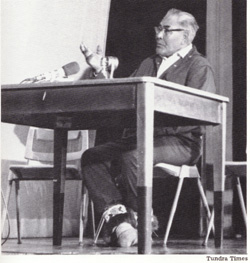 |
| Peter John of Minto |
And 64-year-old Peter John told them of the decline in fur-bearing animals in the Minto area as a result of mining:
They used to get 12 to 15,000 muskrats in one spring. The mink was plentiful, and so was the fox, beaver, and otter . . . Today, you don't see fur signs any place; there are hardly any beaver and no muskrats. I remember last spring we were out hunting muskrats for one week; we caught only 29 rats, that's the poorest ratting I have ever seen in the Minto Flat area. The reason why is because the lakes are drying out and the creeks are full of sand from all of the mining that has been done around Fairbanks and Chatanika and over in Tolovana . . .
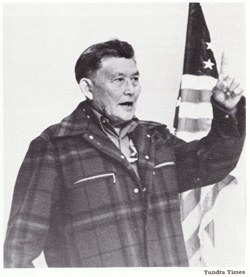 |
| Andrew Isaac, traditional chief of Tanacross |
And they heard 70-year-old Andrew Isaac, chief of the village of Tanacross:
I saw my first white man in 1904. He was a preacher. During the course of the years I saw more white men. In the early 1940's, a highway was built near Tanacross, and white men have come on to our land more and more . . . We made our claim in 1963 because the state came in and selected our land — everything, even our village and graveyard. This is not fair. We own our land — the white man does not . . .
Opposition The principal opposition to the bill at the hearing came from the Alaska Miners' Association. Its spokesman quoted the 1946 Indian Claims Commission Act, which required that claims either be presented before 1951 or that they not be presented at all. Except for such claims filed, he said that:
. . . neither the United States, the State of Alaska, nor any of us here gathered as individuals owes the Natives one acre of ground or one cent of the taxpayers' money . . .
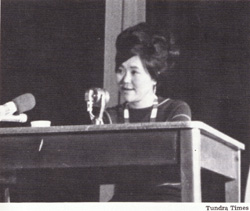 |
| "Take our land, take our life"—Margaret Nick Cooke of Bethel |
The Miners' Association spokesman also warned that a 40-million-acre land settlement would discourage mineral exploration and would possibly reserve the best hunting areas in the state to Natives.
State of Alaska. The administration of Governor Hickel generally supported the AFN bill, but strongly urged the lifting of the land freeze. Because the freeze prevented the issuance of oil leases on federal lands, and because the State was to receive 90 percent of federal revenues from such lands, the State's income was declining. The Governor's representative said the freeze had already cost the State more than $400,000 and unless it were lifted, the State would soon face an economic crisis.
The subject of the land freeze was also taken up by a second critic of the proposed legislation, the Alaska Sportsmen's Council. In a letter to the committee, the Council complained of the bill and the freeze, but observed that the bill could not have gotten even the qualified support of the Hickel administration were it not for the freeze. This observation was perhaps the only point of the Council's testimony with which many Native leaders might agree.
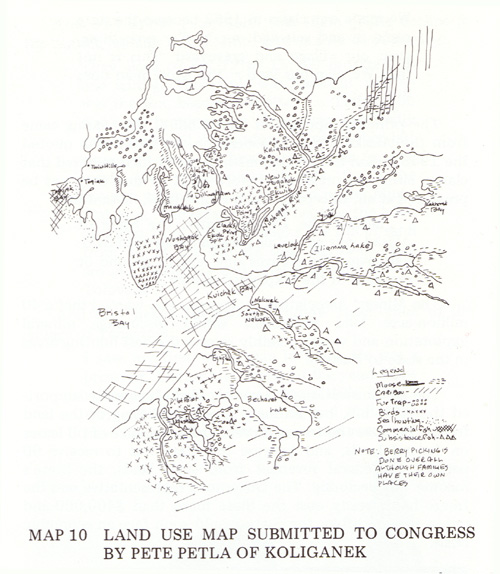 |
| Alaska Native Land Claims Copyright 1976, 1978 by the Alaska Native Foundation |